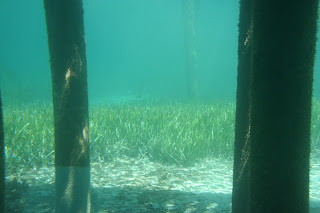 |
| Roatan |
The Island of Roatan, off the coast of Honduras, is situated on the world's
s second largest barrier reef. We had never been there, and had booked a tour that included a ride in a semi-sub, a visit to West End Village, viewing a performance of a native dance and a visit to a cameo factory. We weren't able to dock due to windy conditions, and had to be tendered to shore on the other side of the island from our original landing spot. Many people who had been there before said that this side didn't compare in beauty to the other side, which can only mean that the other side if the island is exquisitely beautiful.
We took a short bus ride through the countryside and arrived at a village with a pristine beach. We were led out a short dock to our semi-sub and made ourselves comfortable. Moments later we were introduced to our tour guide, a Marine Biologist who was doing research on the reef. As we took off, she explained the reef and pointed out various forms of life on the reef.
 |
| Grasses |
 |
| Ocean floor with coral |
There were mountain like structures, and trenches. I was fascinated that they looked like the hills and beaches on the island. It was as if they were the island, and the water came and flowed over them, and now they were below the water. The different forms of coral took on different shapes, but as we toured, all appeared brown or grey.
It was like scuba diving without getting wet. With the engines cut and the sub just drifting in the water, fish grew comfortable enough to swim right up to the boat.
I think that the turbulence in the water from the winds had something to do with the fact that we did not see many different kinds of fish. The ones we did see were magnificent. I tried to get as many pictures as I could, but the fish were cooperating with the other side of the boat more than my side. While I could see, I could not photograph!



No comments:
Post a Comment